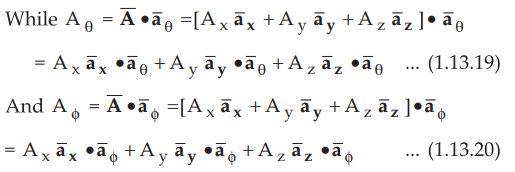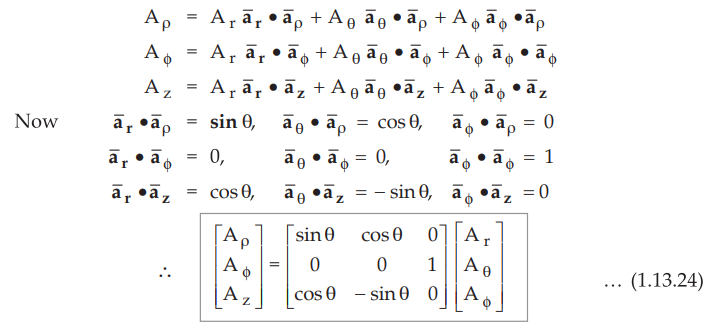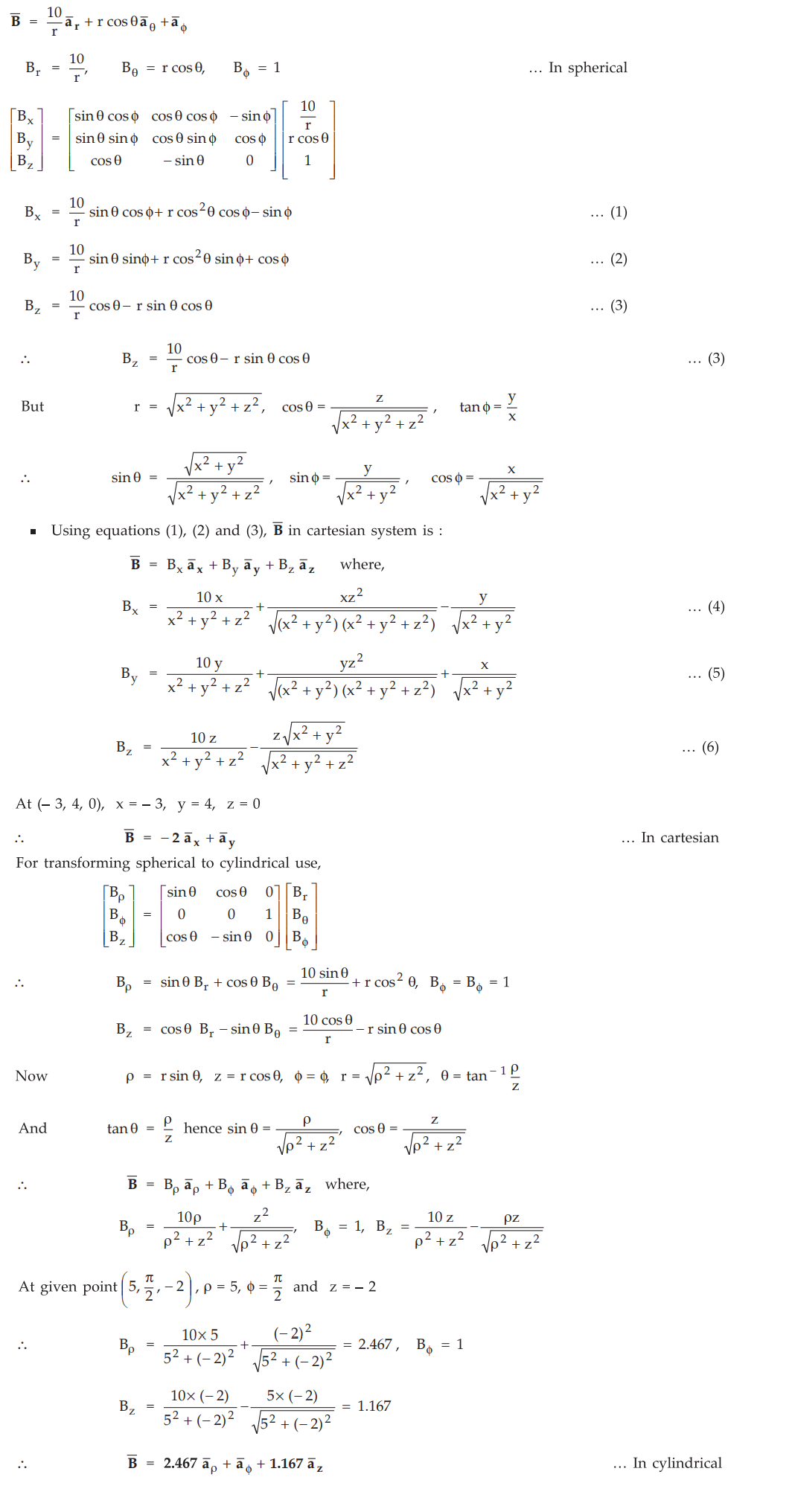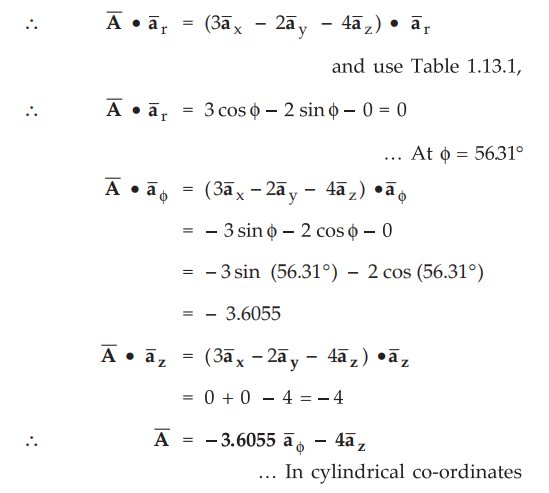Electromagnetic Theory: Unit I: (a) Vector Analysis
Transformation of Vectors
from one coordinate system to other
• Getting familiar with the dot product and cross product, it is possible now to transform the vectors from one co-ordinate system to other co-ordinate system.
Transformation
of Vectors
AU : May-03, 11, 13, 14,19,
Dec.-lO, 12, 13, 14, 16,18
•
Getting familiar with the dot product and cross product, it is possible now to
transform the vectors from one co-ordinate system to other co-ordinate system.
1. Transformation of Vectors from Cartesian to Cylindrical
•
Consider a vector ![]() in cartesian co-ordinate system as,
in cartesian co-ordinate system as,
 ...(1.13.1)
...(1.13.1)
•
While the same vector 7 in cylindrical co-ordinate system can be represented as,
 ...(1.13.2)
...(1.13.2)
•
From the dot product it is known that the component of vector in the direction
of any unit vector is its dot product with that unit vector.
Hence
the component of ![]() in the direction
in the direction ![]() is the dot product of
is the dot product of ![]() with
with ![]() . This component is nothing but Ar.
. This component is nothing but Ar.

•
The magnitudes of all unit vectors is unity hence it is necessary to find angle
between the unit vectors to obtain the various dot products.
• The Fig. 1.13.1 (a) shows three dimensional view of various unit vectors.
•
Consider a xy plane in which the angles between the unit vectors are shown, as
in the Fig. 1.13.1 (b).


• The
result of dot product are summarized in the tabular form as,

•
The results of transformations can be expressed in the matrix form as,

2. Transformation of vectors from Cylindrical to Cartesian
•
Now it is necessary to find the transformation from cylindrical to cartesian
hence assume ![]() is known in cylindrical system. Thus component of
is known in cylindrical system. Thus component of ![]() in
in ![]() direction is given by,
direction is given by,

•
As dot product is commutative  = cos ϕ and so on. Hence referring Table
1.13.1 we can write the results directly as,
= cos ϕ and so on. Hence referring Table
1.13.1 we can write the results directly as,
Ax
= Ar cos ϕ - Aϕ sin ϕ ...(1.13.15)
Ay
= Ar sin ϕ + Aϕ cos ϕ ...(1.13.16)
Az
= Az ...
(1-13-17)
•
The result can be summarized in the matrix form as,


3. Transformation of
Vectors from Cartesian to Spherical
•
Let the vector ![]() expressed in the cartesian system as,
expressed in the cartesian system as,

•
It is required to transform it into spherical system. The component of direction is given by,
direction is given by,

Note : Though
the radius representation r used in cylindrical and spherical systems is same,
the directions ![]() in both the systems are different. Infact many times r
is represented as p in cylindrical system. But ρ is used to represent other
quantity in this book hence r is used in cylindrical system. Hence
in both the systems are different. Infact many times r
is represented as p in cylindrical system. But ρ is used to represent other
quantity in this book hence r is used in cylindrical system. Hence  will be different when
will be different when ![]() is
of spherical system than the
is
of spherical system than the ![]() of cylindrical system and so on.
of cylindrical system and so on.

•
The dot products can be obtained by first taking the projection of spherical
unit vector on the xy plane and then taking the projection onto the desired
axis. Thus for  project
project ![]() on the xy plane which is sin e
and then project on the x axis which is sin θ cos ϕ.
on the xy plane which is sin e
and then project on the x axis which is sin θ cos ϕ.

•
In the similar fashion the other dot products can be obtained. The results of
the dot products are summarized in the Table 1.13.2.

•
Using the results of Table 1.13.2, the results of vector transformation from
cartesian to spherical can be summarized in the matrix form as,

4. Transformation of Vectors from Spherical to Cartesian
•
To find the reverse transformation, assume that the ![]() is known in
spherical system as,
is known in
spherical system as,

•
Hence component of  respectively.
respectively.
•
Thus we get the results as,

•
Using the Table 1.13.2, the results can be expressed in the matrix form as,

5. Distances in all Co-ordinate Systems
•
Consider two points A and B with the position vectors as,

•
then the distance d between the two points in all the three co-ordinate systems
are given by,

•
These results may be used directly in electromagnetics wherever required.
Ex. 1.13.2 Obtain the spherical co-ordinates
of 10 ![]() at the point P (x = -3,y = 2, z = 4).
at the point P (x = -3,y = 2, z = 4).
Sol. :
Given vector is in cartesian system say 
Then  sin θ cos ϕ ... Refer Table 1.13.2
sin θ cos ϕ ... Refer Table 1.13.2
At
point P, x = - 3, y = 2, z = 4
Using
the relationship between cartesian and
spherical,
x = r sin θ cos ϕ y = r sin θ sin ϕ z = r cos θ
ϕ = tan-1 y/x = tan-1
2/-3 = - 33.69°
But
x is negative and y is positive hence ϕ must be between
+90° and +180°. So add 180o to the ϕ to get correct ϕ.
ϕ = - 33.69o + 180° = +
146.31o i.e. cos ϕ = - 0.832 and sin ϕ = 0.5547
And 
6. Transformation of
Vectors from Spherical to Cylindrical
•
Let the vector ![]() is known in the spherical co-ordinates.
is known in the spherical co-ordinates.

•
The components of ![]() in cylindrical system are given by,
in cylindrical system are given by,

7. Transformation of Vectors from Cylindrical to Spherical
•
Let the vector ![]() is known in the cylindrical co-ordinates.
is known in the cylindrical co-ordinates.

•
The components of ![]() in the spherical system are given by,
in the spherical system are given by,

Key point : To
avoid the confusion between ![]() , in cylindrical and spherical in the
cylindrical system
, in cylindrical and spherical in the
cylindrical system ![]() , is used.
, is used.
•
Using equations (1.13.24) and (1.13.25), any vector can be converted from
cylindrical to spherical or spherical to cylindrical system.
Ex. 1.13.3
Express vector ![]() in cartesian and
cylindrical systems. Given
in cartesian and
cylindrical systems. Given

Then find ![]() at ( -3,4,0) and ( 5,
π/2,-2) AU : Dec.-13,18,May-19,Marks
16
at ( -3,4,0) and ( 5,
π/2,-2) AU : Dec.-13,18,May-19,Marks
16
Sol. :


Ex. 1.13.5
Given point P (-2, 6, 3) and ,
express P and
,
express P and ![]() in cylindrical co-ordinates. AU : Dec.-12, Marks 8
in cylindrical co-ordinates. AU : Dec.-12, Marks 8
Sol. :
Refer example 1.13.4 for P in cylindrical system.
P (6.3245, 108.43°, 3) ...Cylindrical
To
convert ![]() to cylindrical,
to cylindrical,

Ex. 1.13.6
Given point P (-1, 4, 3) and vector  express and A in cylindrical and
spherical coordinates. Evaluate
express and A in cylindrical and
spherical coordinates. Evaluate ![]() at P in the cartesian and spherical
systems.AU: May-11,Marks 8
at P in the cartesian and spherical
systems.AU: May-11,Marks 8
Sol. :
Refer example 1.13.4 and 1.13.5 for the procedure and verify the answers as :
i) P (√17,
104.036°, 3) in cylindrical.
ii) P(√26, +104.036°, +53.96°) in spherical.

Ex. 1.13.7 Transform
the vector  at P (x = + 2, y = + 3, z = 4) to spherical
co-ordinate. AU
: Dec.-lO, Marks 16
at P (x = + 2, y = + 3, z = 4) to spherical
co-ordinate. AU
: Dec.-lO, Marks 16
Sol.
: Refer example 1.13.4 for the procedure and verify the answer as,
i) P (5.385, 42.03°, 56.31a)
ii)  in spherical system at P
in spherical system at P
Ex. 1.13.8 Transform the vector  at P(x = 2, y = 3, z = 3) to cylindrical co-ordinate. AU : May-14, Marks 8
at P(x = 2, y = 3, z = 3) to cylindrical co-ordinate. AU : May-14, Marks 8
Sol. :
At point P, x = 2, y = 3, z = 3 hence in cylindrical,
r
= √x2 + y2 = √13, ϕ = tan-1 y/x = 56.31°, z =
3
In
this example,
Note
that i, j, k are unit vectors in cartesian system and are generally represented
as  respectively.
respectively.

Examples for Practice
Ex. 1.13.9 Give the cartesian co-ordinates of
the vector field  at point P (x = 5,y 2,z = -1).
at point P (x = 5,y 2,z = -1).

Ex. 1.13.10
Given points A(x = 2, y = 3, z = - 1) and
B(ρ = 4, ϕ = - 50°, z = 2) find the distance A to B. [Ans.: 6.7896]
Review Question
1. How to transform
the vectors from one coordinate system to other ?
Electromagnetic Theory: Unit I: (a) Vector Analysis : Tag: : from one coordinate system to other - Transformation of Vectors
Related Topics
Related Subjects
Electromagnetic Theory
EE3301 3rd Semester EEE Dept | 2021 Regulation | 3rd Semester EEE Dept 2021 Regulation
